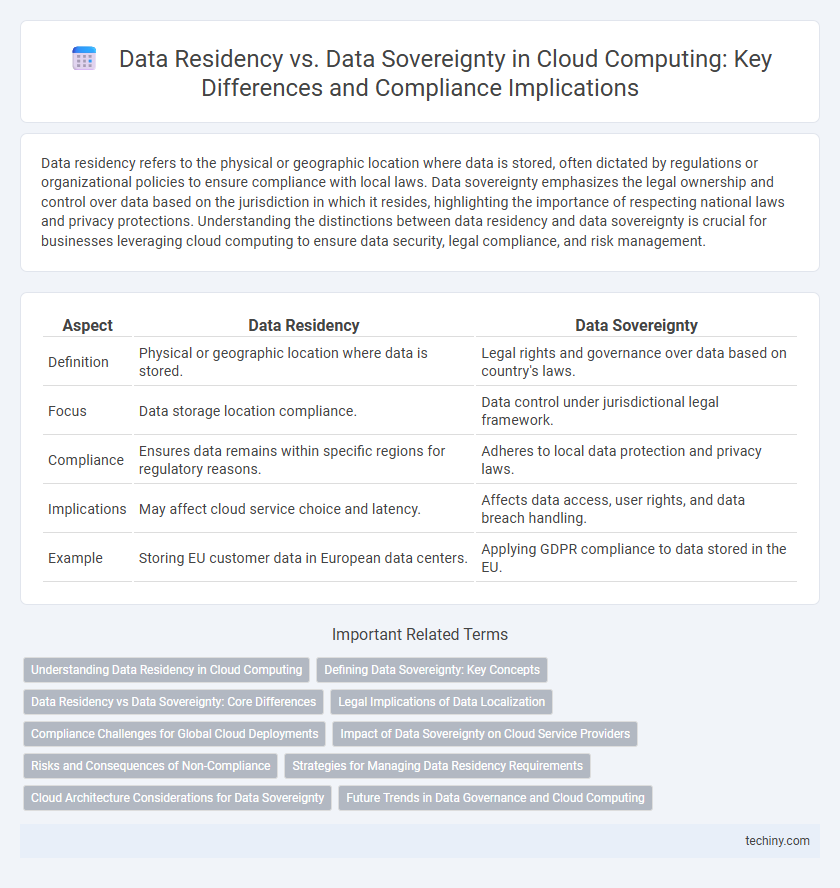Data residency refers to the physical or geographic location where data is stored, often dictated by regulations or organizational policies to ensure compliance with local laws. Data sovereignty emphasizes the legal ownership and control over data based on the jurisdiction in which it resides, highlighting the importance of respecting national laws and privacy protections. Understanding the distinctions between data residency and data sovereignty is crucial for businesses leveraging cloud computing to ensure data security, legal compliance, and risk management.
Table of Comparison
| Aspect | Data Residency | Data Sovereignty |
|---|---|---|
| Definition | Physical or geographic location where data is stored. | Legal rights and governance over data based on country's laws. |
| Focus | Data storage location compliance. | Data control under jurisdictional legal framework. |
| Compliance | Ensures data remains within specific regions for regulatory reasons. | Adheres to local data protection and privacy laws. |
| Implications | May affect cloud service choice and latency. | Affects data access, user rights, and data breach handling. |
| Example | Storing EU customer data in European data centers. | Applying GDPR compliance to data stored in the EU. |
Understanding Data Residency in Cloud Computing
Data residency in cloud computing refers to the physical or geographic location where data is stored and processed by cloud service providers. Understanding data residency is crucial for compliance with regional regulations, ensuring data latency optimization, and maintaining data security standards specific to local jurisdictions. Cloud customers must evaluate providers' data center locations and data handling policies to align with organizational and legal requirements.
Defining Data Sovereignty: Key Concepts
Data sovereignty refers to the legal framework that governs data based on the laws of the country where the data is physically stored, emphasizing jurisdictional control and compliance requirements. It impacts cloud computing strategies by mandating that organizations must adhere to local regulations regarding data privacy, access, and protection. Understanding data sovereignty is essential for managing cloud environments across multiple regions, ensuring data governance aligns with national legislation.
Data Residency vs Data Sovereignty: Core Differences
Data residency defines where data is physically stored, affecting compliance with local regulations, while data sovereignty refers to the legal ownership and control over data within a specific jurisdiction. Data residency primarily concerns data storage location constraints imposed by regional laws or industry standards, whereas data sovereignty emphasizes jurisdictional authority and control over data access and processing. Understanding these core differences is crucial for organizations managing cloud computing environments to ensure both regulatory compliance and data governance.
Legal Implications of Data Localization
Data residency refers to the physical location where data is stored, while data sovereignty emphasizes the governance and legal control a country exercises over data within its borders. Legal implications of data localization include compliance with local data protection laws, restrictions on cross-border data transfers, and potential penalties for non-compliance, which can affect cloud service providers and multinational companies. Understanding data sovereignty laws such as the EU's GDPR or China's Cybersecurity Law is crucial for ensuring lawful data management and minimizing legal risks in cloud computing.
Compliance Challenges for Global Cloud Deployments
Data residency and data sovereignty present significant compliance challenges in global cloud deployments due to varying legal frameworks governing data storage and processing across jurisdictions. Organizations must navigate complex regulations such as GDPR in Europe, CCPA in California, and other regional data protection laws that mandate specific data localization requirements. Ensuring compliance requires implementing robust data governance strategies, continuous monitoring, and cloud architectures that support data segregation and access controls tailored to each regulatory environment.
Impact of Data Sovereignty on Cloud Service Providers
Data sovereignty imposes strict legal and regulatory requirements on cloud service providers, requiring them to store and process data within specific geographic boundaries to comply with national laws. This often leads to increased infrastructure costs and complexity as providers must establish localized data centers or partner with regional entities to meet data residency mandates. Cloud providers face challenges in ensuring data privacy, security, and compliance simultaneously, affecting service delivery and scalability in multinational deployments.
Risks and Consequences of Non-Compliance
Data residency and data sovereignty regulations impose strict requirements on where data must be stored and processed, with non-compliance exposing organizations to significant legal penalties and financial fines under laws such as GDPR and CCPA. Risks include increased vulnerability to data breaches, operational disruptions, and loss of customer trust due to unauthorized data transfers across jurisdictions. Failure to adhere to these frameworks can result in severe reputational damage, regulatory investigations, and costly remediation efforts impacting overall business continuity.
Strategies for Managing Data Residency Requirements
Organizations implement data residency strategies by selecting cloud service providers with data centers located in jurisdictions that comply with local data storage regulations. Employing data localization techniques, such as encrypting data and using hybrid or multi-cloud environments, ensures that sensitive information remains within prescribed geographic boundaries. Regular compliance audits and automated policy enforcement help maintain adherence to evolving regulatory frameworks governing data residency.
Cloud Architecture Considerations for Data Sovereignty
Data sovereignty in cloud computing requires organizations to design cloud architectures that ensure data remains within specific geographic boundaries dictated by local regulations. Leveraging region-specific data centers and implementing geo-fencing technologies are critical to maintaining compliance with sovereign data laws. Cloud architects must prioritize encryption, access controls, and audit trails to enforce data residency requirements while supporting scalable, secure cloud deployments.
Future Trends in Data Governance and Cloud Computing
Future trends in data governance and cloud computing emphasize enhanced data residency frameworks that enable organizations to store data within specific geographic boundaries, aligning with evolving regulatory requirements. Emerging technologies like confidential computing ensure data sovereignty by protecting data privacy and control even when processed in third-party cloud environments. Increasing adoption of decentralized cloud architectures and AI-driven compliance tools will further empower enterprises to manage data governance effectively while maintaining sovereignty across global jurisdictions.
Data Residency vs Data Sovereignty Infographic

 techiny.com
techiny.com